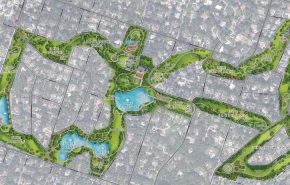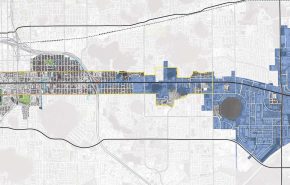GAI Community Solutions Group professionals Pete Sechler, Blake Drury, and Jeremy Ringer offer insight into the continuing trend of golf course conversion projects to benefit communities and serve new generations of players.
When Seminole County, Florida recently publicized its plan to convert the former Deer Run golf course into a community park, it reflected a continuing trend on the part of municipalities and developers to explore ways to rethink these large green spaces to better serve an inclusive range of interests and community members.
In presenting the Deer Run Community Park Conceptual Master Plan developed by GAI’s Community Solutions Group, the county revealed a fresh vision that will bring a range of exciting new amenities to the region. The Community Solutions Group (CSG) is GAI’s community-based infrastructure and design practice, a comprehensive and collaborative team comprising experienced landscape architects, urban designers, land-use planners, public finance and economic development specialists, public administrators, and more.
“In much U.S. land development from the 1950’s through the early 1990’s, golf was one of the preeminent amenities included in many master-planned communities,” said GAI VP and CSG leader Pete Sechler, PLA, AICP, MBA. Indeed, the National Golf Foundation (NGF) reports that there are currently more than 15,000 golf courses across the United States, outnumbering the nation’s McDonald’s restaurant locations. However, some 1,500 golf courses across the country have closed since 2014 according to research group IBISWorld, leaving significant open space primed for conversion to parks, revamped golf courses, and a range of development possibilities.
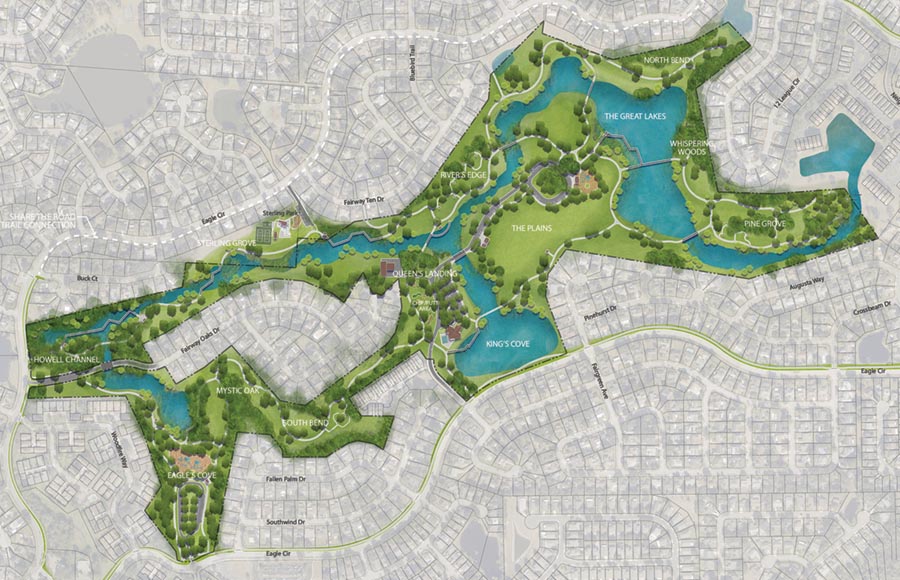
Getting Back to Nature
“Much of the trend to develop these facilities in Florida was driven by people with the dream of retiring to the state and playing golf,” said Sechler. “Today, there’s a lot more interest in other forms of recreation, in particular personal health activities like bicycling, trail walking, jogging, and the like.”
The move to convert golf courses into natural recreational spaces is exemplified in projects like Deer Run Community Park and the Rolling Hills Community Park Master Plan that GAI’s CSG also created for Seminole County. “The conversion of a golf course with high maintenance costs to a park with far lower maintenance costs is a pretty attractive option for clients, and since I moved to Florida in 1990, I’ve observed a growing appreciation by residents for the area’s natural ecology as an alternative to the highly manicured character of a golf course,” said Sechler.
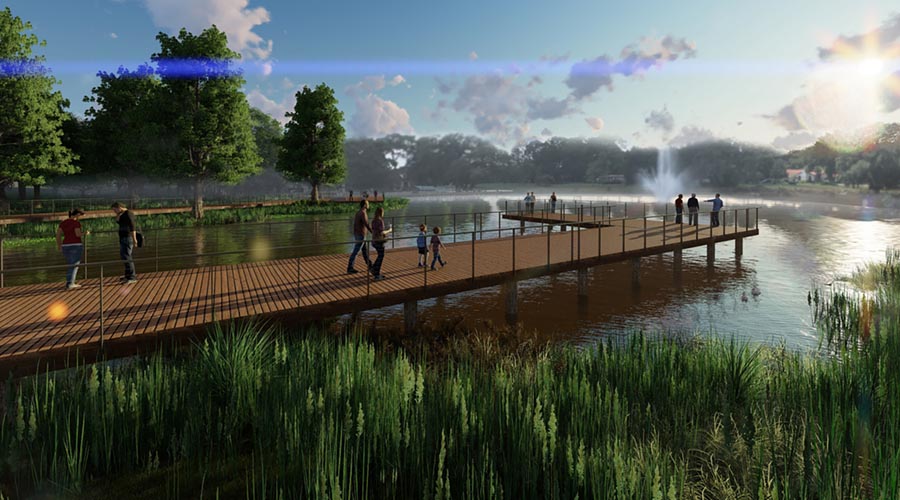
Fostering Sustainable Development
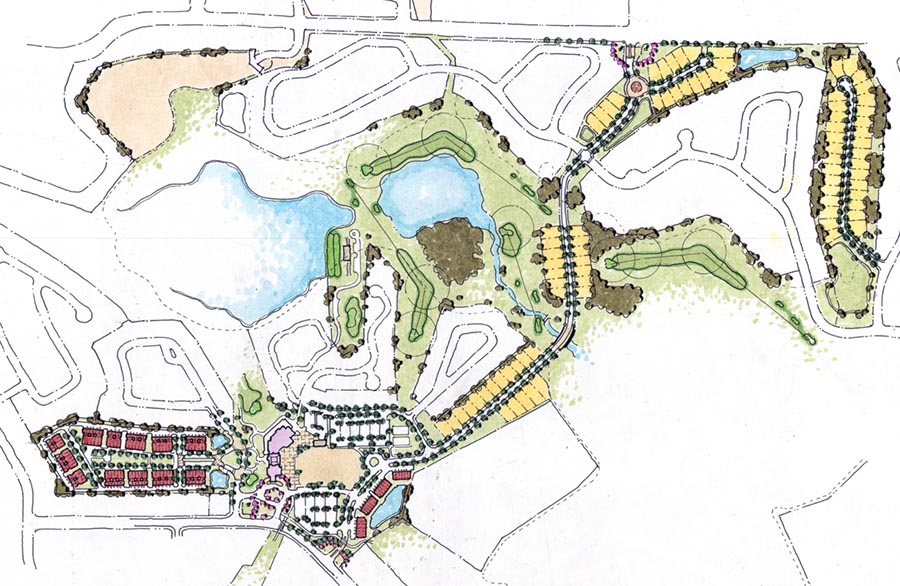
The open space offered by closed golf courses presents a prime opportunity for development as well. “Particularly in the state of Florida, residential has been under built for so long that we are in a situation where it’s really hard to catch up,” said GAI AVP and Planning Director Blake Drury, AICP. “While there’s now a general trend toward redevelopment and infill, there aren’t that many places where you can find 100 acres in a populated area to do these sorts of projects. So, closed or closing golf courses often end up as targets for development.”
Drury describes successful golf course development projects as a series of complex and interrelated steps: “I think of the process as a series of ‘gates,’ each of which will determine if you’ll move on to the next gate. First is due diligence, which includes identifying any entitlements and easements as well as physical infrastructure components like flood plains and wetlands. The succeeding design phase strives to balance the client’s plans with the actual physical considerations of the project site and feedback drawn from engagement with area stakeholders.”
Drury believes that early and sustained engagement is a key to project success. “There’s a phrase I’ve heard to the effect of, ‘If I bring you in at the beginning of the project, you’re my partner; if I bring you in at the end of the project, you’re my judge.’ So, there’s a lot to be gained for developers by being upfront with the neighbors and trying to engage them as fans of the project early on. I’ve even seen cases where the developer will literally set up in the course’s old clubhouse and hold regular office hours when interested neighbors could drop in to view the plans and ask questions.”
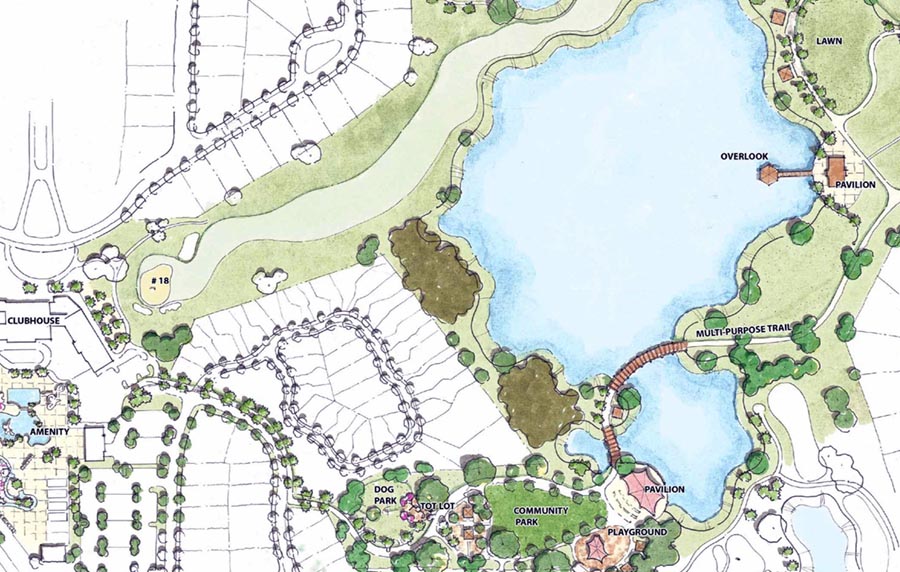
Setting New Courses
For projects in which clients seek to alter existing golf courses, GAI Senior Planning Manager Jeremy Ringer brings a nearly 20-year background in golf course design to help reconfigure facilities to serve new generations of players. “Much of my design process is informed by a combination of placemaking, an approach that seeks to create places that people truly care about and that function well for them, and geodesign, a design method in which community stakeholders, designers, clients, and others collaborate on considering a defined series of questions to arrive at sustainable design decisions,” said Ringer. “So, for instance, when the goal is a golf course conversion to accommodate development while encouraging a wider group of people to get involved in the game, the result of the process might mean paring an 18-hole course down to 9 holes—an outcome that can speed up the game, better accommodate varying skill levels, and free up acreage for other purposes.”
Throughout, Ringer’s placemaking and geodesign background helps produce designs that will be appreciated by the community and its residents while fulfilling client goals. “It’s all about inclusiveness,” said Ringer. “Golf country clubs are always going to exist, but these might present cost barriers or seem old-fashioned to some folks. The successful modern golf course conversion seeks an all-encompassing fix for sustainability that provides the client with increased revenue and boosts the number of rounds played by being inclusive of more types of golfers—often people who otherwise might not have become interested in the game.”
Inclusive & Collaborative Golf Course Conversion Solutions
“In my view, Florida has many older golf courses that require new ways of thinking in order to better appeal to current and future generations,” said Sechler. “An inclusive goal and a collaborative process are significant contributors to success.” Success for GAI’s CSG clients is bolstered by cross-functional collaboration among the CSG team and hundreds of experienced multidiscipline professionals across GAI’s many practice areas. “Our process leverages GAI CSG disciplines including urban design and neighborhood planning, park system planning, redevelopment process and design, and landscape architecture placemaking in collaboration with civil engineering, traffic engineering, environmental, stormwater management, archaeological resource, and many other professional services across GAI,” said Sechler. “Just as fostering collaboration among regional stakeholders helps envision project goals that truly function for the community, collaboration among GAI’s diverse and experienced staff works to create the sustainable solutions that bring that vision to life.”
Contact GAI’s Community Solutions Group representatives Pete Sechler, PLA, AICP, MBA, 312.319.3126; Blake Drury, AICP, 321.319.3125; or Jeremy Ringer, 904.559.8103 for more information about GAI’s range of community and parks planning, golf course conversion, landscape architecture, and economics services—message GAI and start the conversation about how our multidiscipline professionals can meet your unique project needs.
![]() Peter Sechler, PLA, AICP, MBA directs GAI’s Community Solutions Group. He specializes in urban design, campus planning, and landscape design projects in the eastern United States for public, private, and institutional clients. His approach is to work inclusively, identifying community mission, environmental context, and underlying economic potential. This positions specific initiatives to realize enhanced livability while supporting broader goals, authenticity, and sustainable success for the communities he serves.
Peter Sechler, PLA, AICP, MBA directs GAI’s Community Solutions Group. He specializes in urban design, campus planning, and landscape design projects in the eastern United States for public, private, and institutional clients. His approach is to work inclusively, identifying community mission, environmental context, and underlying economic potential. This positions specific initiatives to realize enhanced livability while supporting broader goals, authenticity, and sustainable success for the communities he serves.
![]() Blake Drury, AICP specializes in urban design and city planning focused on creating livable communities. He has developed plans for public-sector clients in urban, suburban, and rural settings across North America, including initiation, conceptualization, and design of large-scale neighborhood redevelopment projects, downtown plans, and numerous transit station area planning programs. Blake has extensive experience helping private-sector clients develop visions and principles to guide new communities, including master plans for many traditional neighborhood development design projects throughout the southeastern United States.
Blake Drury, AICP specializes in urban design and city planning focused on creating livable communities. He has developed plans for public-sector clients in urban, suburban, and rural settings across North America, including initiation, conceptualization, and design of large-scale neighborhood redevelopment projects, downtown plans, and numerous transit station area planning programs. Blake has extensive experience helping private-sector clients develop visions and principles to guide new communities, including master plans for many traditional neighborhood development design projects throughout the southeastern United States.
![]() Jeremy Ringer serves as Director of Community Development for GAI’s Community Solutions Group with a focus on private and public clients throughout northeast Florida and beyond. He has more than 20 years of experience in placemaking, landscape architecture, planning, and golf course design to assist developers and builders through all project stages.
Jeremy Ringer serves as Director of Community Development for GAI’s Community Solutions Group with a focus on private and public clients throughout northeast Florida and beyond. He has more than 20 years of experience in placemaking, landscape architecture, planning, and golf course design to assist developers and builders through all project stages.

